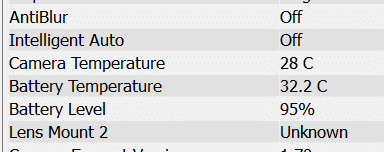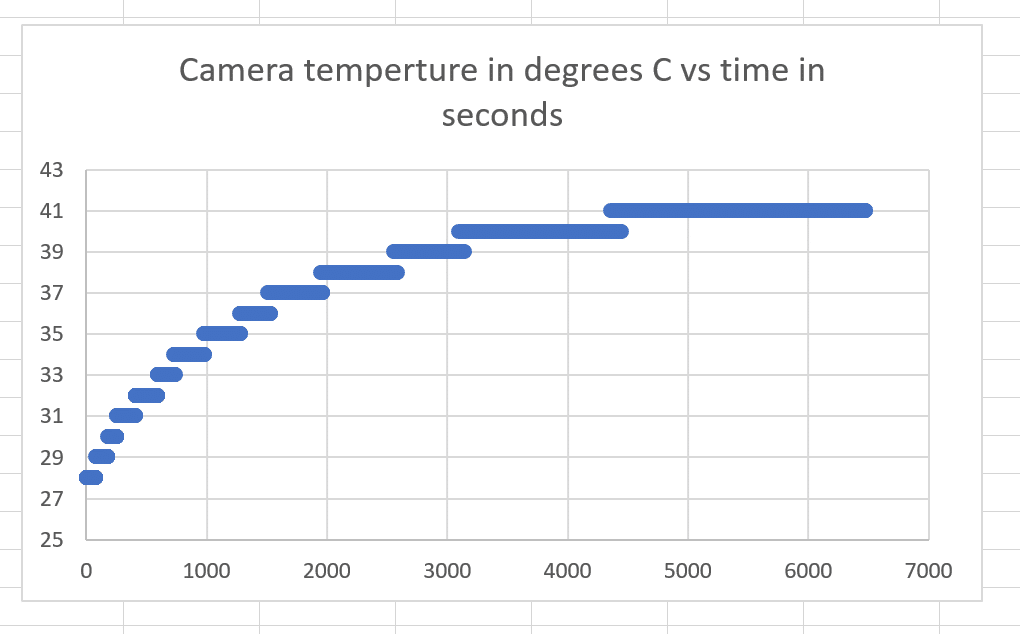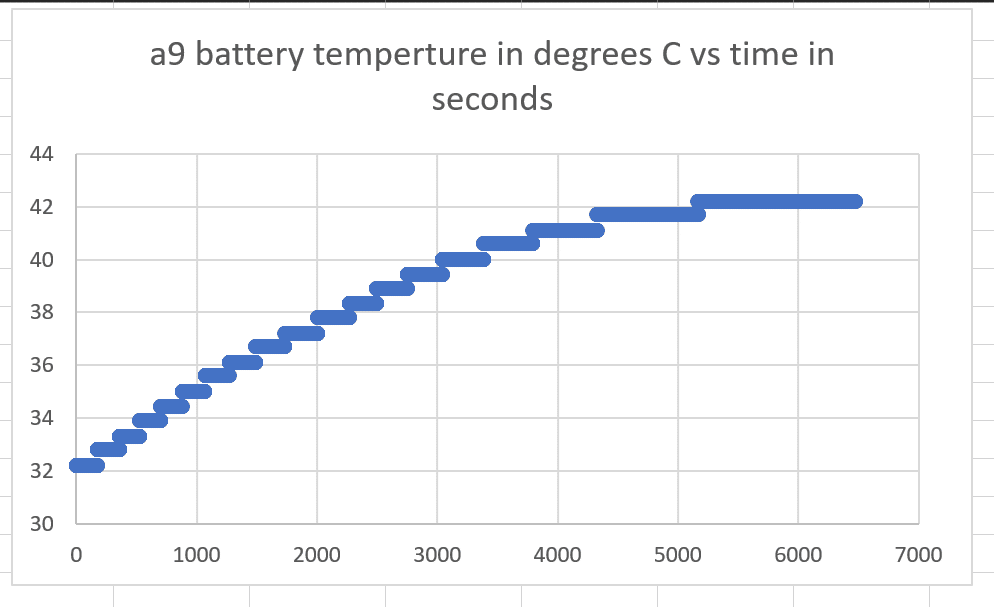This is the ninth in a series of posts on the Sony a9. The series starts here.
There have been reports of Sony a9s shutting down because of internal temperature buildup. There are many camera modes that can affect power consumption, and I hope to eventually be able to do the fixturing to measure that directly as I have done with the a7RII so that we’ll know what modes to avoid on hot days.
But today I did something simpler. In a 25-degree C room, made a series of 6475 1/10 second electronic shutter exposures 1 second apart of the back of the body cap with the ISO set to 1000, the camera in single shot mode, the file type to raw compressed. That took a bit under 2 hours. The LCD screen was flat to the body. Here’s a look at the camera and battery temperatures at the beginning of the test.
And at the end:
The battery temperature rose 10 degrees C, and the camera temperature 13 degrees. I expect that nearly two hours is long enough to get the camera temperature pretty close to equilibrium.
Here are the stats for the full frame at the beginning:
And at the end:
The column to look at is the last one, which is the sigma, or standard deviation, and is also the rms value of the dark-field noise. There is virtually no change.
Here are full frame histograms:


There are no significant differences. The distribution looks Gaussian in both cases.
At the end of the test, the camera was warm, but not hot, to the touch.
I would expect that in a environment 15 degree hotter, that the start and end temperatures would have gone up by 15 degrees. That would have put the camera temperature at 57 degrees C or 134 degrees Fahrenheit. I don’t know if that would have caused the camera to shut down.
[Added 6/1: I just received the following message from a reader who goes by MikeSul on DPR:
I have sets of photos from two days where the warning came on. On both days I continued shooting and the camera never shut down. The first day the warning came on and off over about half an hour after it began about 45 minutes into the shoot. I am in Phoenix and the temp was at or slightly above 100f all the time.
I asked Mike for the EXIF values for the camera and battery temperatures when the warning came on. This is what he said:
…when the warning came on the camera was 48c and the battery was 47.8. The hottest it got (about 20 minutes later) was camera 53c and battery 49.4. I was in direct sun for about an hour and a half. Airplane mode. I made no effort to shield the camera or 24-70gm lens.
We still don’t know the temperature that causes the camera to shut down. Let’s assume the camera temp is the one that the a9 uses to decide whether to warn the user about overtemp, and that 48 degrees C is the threshold. Ignoring the sun load for the time being, lets convert 100 degrees F to 38 degrees C.
In my tests above, I saw a rise in the camera temperature of 16 degrees C over ambient. Had the ambient been 38 degrees C, that would have gotten the camera to 54 degrees C, and triggered the warning. I am surprised the warning temperature is so low in a camera whose maximum ambient operating temperature is 40 degrees C. That only allows for an 8 degree C rise before the warning comes on.
Here are graphs of the camera and battery temperatures versus time:
Looks like an exponential, as you’d expect. The time constant is about half an hour.
If you go to Suitcase > page 2/7, you’ll see Auto Pwr OFF Temp. There are two settings, standard (the default) and High. If you set it to High, it sounds like it’s setting the actual turn off temp higher. It may also be setting the warning higher. It probably isn’t just setting the warning higher.
One side note: about 6500 exposures drew the battery down from 95% to 57%. That’s pretty darned good.






Please test the camera the way it was originally marketed to shoot. Which is lots of 20fps bursts for the duration of a sporting event (outdoors and hot).
You were not using the AF motor, the LCD screen was not used to preview images, the EVF wasnt on, nor the IBIS in use. What a terriblly useless test.
You are welcome to run the tests any way you’d like and report the results. I’d appreciate that. You are not welcome to order me to do tests the way you want them done.
In previous a7x tests, AF has not been a big power consumer, but sensor scanning has. I’ll be testing for that. As to the 20 fps bursts, with the memory card that I used (95 MB/s), holding the shutter button down in Ch rapidly fills the buffer and now you’re at — guess what? — about a frame per second.
This is just the first look. After I start measuring a9 power consumption, I’ll know what the worst-case modes are.
Hello Mr. Kasson,
Your tests and effort is appreciated. With regard to this one, though, I have a thought about a significant component that you may have not considered. It’s an element that’s at the core of photography: light!
Could the amount of light hitting the sensor have an effect on the heating?
I confess to never having pondered it before, but given that most of us will be well aware of how warm you can feel sitting behind a sunlit window, I’m wondering if the simple brightness of an image might be a significant factor.
It is possible that the amount of light hitting the sensor might have a measurable effect upon its temperature. All the photons absorbed by the sensor heat it. If there were no lens on the camera, and you aimed it straight at the sun, and the sensor were totally black, it would absorb about 1000 watts per square meter, or 864 / 1000 watts for a FF sensor. Call it a watt. But we don’t aim our cameras at the sun for very long, at least if we expect them to survive the experience. The sun is about 400,000 times brighter than an 18% gray card, so now we’re talking about a few microwatts. Yes, the lens settings affect this, but we’re just looking for a ballpark figure.
For comparison, the Sony a9 battery has just over 16 watt-hours of capacity. Say we’re discharging it at a rate that will give us four hours of battery life. That’s 4 watts.
I don’t know of a reason why processing a bright image is materially more energy intensive than processing a dime one.
Small correction — there are 1kW reaching the atmosphere, only about 860 make it to the surface.
With the help of synapsy’s instructions and per his request, here are the results of my AF-C up to 20FPS motocross shoot with the A9 handheld. 1199 files in about 2.5 hours. Full sun/91F
https://www.dropbox.com/sh/z5l53807rc9rm1l/AAAKu14d_ZaFHKg7B1_r0lLsa?dl=0
P.S. I never noticed any over heating warning or experienced any shut downs. A9 performed as expected.